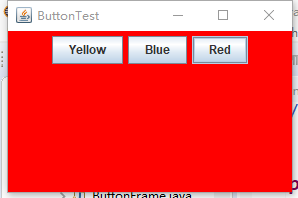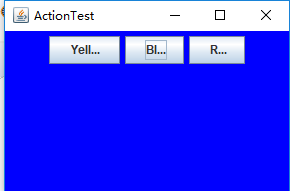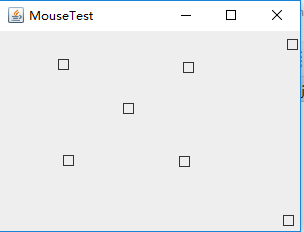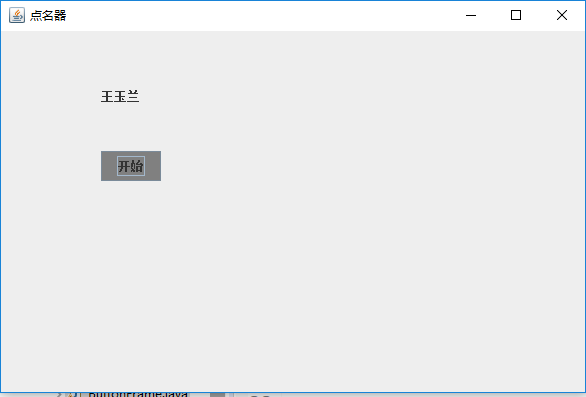第一部分:基础理论知识
1.事件处理基础
事件源(event source):能够产生事件的对象都可 以成为事件源,如文本框、按钮等。一个事件源是一个 能够注册监听器并向监听器发送事件对象的对象。
事件监听器(event listener):事件监听器对象接 收事件源发送的通告(事件对象),并对发生的事件作 出响应。一个监听器对象就是一个实现了专门监听器接 口的类实例,该类必须实现接口中的方法,这些方法当 事件发生时,被自动执行。
事件对象(event object):Java将事件的相关信息 封装在一个事件对象中,所有的事件对象都最终派生于 java.util.EventObject类。不同的事件源可以产生不 同类别的事件。
监听器对象:是一个实现了特定监听器接口( listener interface)的类实例。
事件源:是一个能够注册监听器对象并发送事件对 象的对象。
当事件发生时,事件源将事件对象自动传递给所 有注册的监听器。
监听器对象利用事件对象中的信息决定如何对事 件做出响应。
程序员需完成的两个步骤(在GUI设计里)
1)定义实现某事件监听器接口的事件监听器类,并具体化接口中声明的事件处理抽象方法。
2) 为组件注册实现了规定接口的事件监听器对象;
2.动作
动作事件(ActionEvent):当特定组件动作(点 击按钮)发生时,该组件生成此动作事件。
该 事 件 被 传 递 给 组 件 注 册 的 每 一 个 ActionListener 对象, 并 调 用 监 听 器 对 象 的 actionPerformed方法以接收这类事件对象。
能够触发动作事件的动作,主要包括: (1) 点击按钮 (2) 双击一个列表中的选项; (3) 选择菜单项; (4) 在文本框中输入回车。
3.监听器接口的实现:
监听器类必须实现与事件源相对应的接口,即必 须提供接口中方法的实现。
A:创建按钮对象 JButton类常用的一组构造方法: (1) JButton(String text):创建一个带文本的按钮。
(2) JButton(Icon icon) :创建一个带图标的按钮。
(3)JButton(String text, Icon icon) :创建一个带文本和图标 的按钮。
B:按钮对象的常用方法 ① getLabel( ):返回按钮的标签字符串; ② setLabel(String s):设置按钮的标签为字符串s
4.鼠标事件
鼠标事件 – MouseEvent A:鼠标监听器接口 – MouseListener – MouseMotionListener B:鼠标监听器适配器 – MouseAdapter – MouseMotionAdapter
用户点击鼠标按钮时,会调用三个监听器方法:
– 鼠标第一次被按下时调用mousePressed方法;
– 鼠标被释放时调用mouseReleased方法;
– 两个动作完成之后,调用mouseClicked方法。
A: 鼠标在组件上移动时,会调用mouseMoved方法。
B:如果鼠标在移动的时候还按下了鼠标,则会调用 mouseDragged方法。
鼠标事件返回值 – 鼠标事件的类型是MouseEvent,当发生鼠标事件时:
MouseEvent类自动创建一个事件对象,以及事件发生 位置的x和y坐标,作为事件返回值。
MouseEvent类中的重要方法 – public int getX( ); – public int getY( ); – public Point getPoint( ); – public int getClickCount( );
5.AWT事件继承层次:
所有的事件都是由java.util包中的EventObject 类扩展而来。
A: AWTEevent 是所有AWT 事件类的父类, 也是 EventObject的直接子类。
B: 有些Swing组件生成其他类型的事件对象,一般直 接 扩 展 于 EventObject, 而不是AWTEvent,位于 javax.swing.event.*。
C: 事件对象封装了事件源与监听器彼此通信的事件 信息。在必要的时候,可以对传递给监听器对象的 事件对象进行分析。
第二部分:实验
1、实验目的与要求
(1) 掌握事件处理的基本原理,理解其用途;
(2) 掌握AWT事件模型的工作机制;
(3) 掌握事件处理的基本编程模型;
(4) 了解GUI界面组件观感设置方法;
(5) 掌握WindowAdapter类、AbstractAction类的用法;
(6) 掌握GUI程序中鼠标事件处理技术。
2、实验内容和步骤
实验1: 导入第11章示例程序,测试程序并进行代码注释。
测试程序1:
l 在elipse IDE中调试运行教材443页-444页程序11-1,结合程序运行结果理解程序;
l 在事件处理相关代码处添加注释;
l 用lambda表达式简化程序;
l 掌握JButton组件的基本API;
l 掌握Java中事件处理的基本编程模型。
package button;
import java.awt.*;
import java.awt.event.*;
import javax.swing.*;
/**
* A frame with a button panel
*/
public class ButtonFrame extends JFrame
{
private JPanel buttonPanel;
private static final int DEFAULT_WIDTH = 300;
private static final int DEFAULT_HEIGHT = 200;
public ButtonFrame()
{
//调整组件的大小,宽度和高度
setSize(DEFAULT_WIDTH, DEFAULT_HEIGHT);
// 创建了三个按钮对象
JButton yellowButton = new JButton("Yellow");
JButton blueButton = new JButton("Blue");
JButton redButton = new JButton("Red");
buttonPanel = new JPanel();
// 向面板添加按钮
buttonPanel.add(yellowButton);
buttonPanel.add(blueButton);
buttonPanel.add(redButton);
//将面板添加到框架
add(buttonPanel);
// 创建按钮对象
ColorAction yellowAction = new ColorAction(Color.YELLOW);
ColorAction blueAction = new ColorAction(Color.BLUE);
ColorAction redAction = new ColorAction(Color.RED);
// 将动作与按钮相关联
yellowButton.addActionListener(yellowAction);
blueButton.addActionListener(blueAction);
redButton.addActionListener(redAction);
}
/**
* An action listener that sets the panel's background color.
*/
private class ColorAction implements ActionListener
//ColorAction类后面实现了一个监听器接口类ActionListener
{
private Color backgroundColor;
//Color 类用于封装默认 sRGB 颜色空间中的颜色,或者用于封装由 ColorSpace 标识的任意颜色空间中的颜色
public ColorAction(Color c)
{
backgroundColor = c;
}
public void actionPerformed(ActionEvent event)
{
buttonPanel.setBackground(backgroundColor);
}
}
}
package button;
import java.awt.*;
import javax.swing.*;
/**
* @version 1.34 2015-06-12
* @author Cay Horstmann
*/
public class ButtonTest
{
public static void main(String[] args)
{
//lambda表达式
EventQueue.invokeLater(() -> {
JFrame frame = new ButtonFrame();
frame.setTitle("ButtonTest");
//setTitle表示将此窗体的标题设置为制定的字符串
frame.setDefaultCloseOperation(JFrame.EXIT_ON_CLOSE);
//根据参数的值显示或隐藏窗口
frame.setVisible(true);
});
}
}
运行结果:

以下是分别用三种方法对上面的程序进行化简程序,但是结果一样
package button;
import java.awt.*;
import java.awt.event.*;
import javax.swing.*;
/**
* A frame with a button panel
*/
public class ButtonFrame extends JFrame {
private JPanel buttonPanel;
private static final int DEFAULT_WIDTH = 300*2;
private static final int DEFAULT_HEIGHT = 200*2;
public ButtonFrame() {
setSize(DEFAULT_WIDTH, DEFAULT_HEIGHT);
//用new运算符调用构造器
buttonPanel = new JPanel();
//创建按钮生成了三个按钮对象
makeButton("黄色", Color.yellow);
makeButton("蓝色", Color.blue);
makeButton("红色", Color.red);
makeButton("绿色",Color.green);
add(buttonPanel);
}
protected void makeButton(String name,Color backgound) {
// 创建按钮
JButton button = new JButton(name);
// 向面板添加按钮
buttonPanel.add(button);
// 创建按钮操作
//方法一:通过内部类方式实现
/*ColorAction action = new ColorAction(backgound);
// associate actions with buttons
button.addActionListener(action);*/
//方法二:匿名内部类方式实现
button.addActionListener(new ActionListener() {
@Override
public void actionPerformed(ActionEvent e) {
// TODO 自动生成的方法存根
buttonPanel.setBackground(backgound);
}
});
//方法三通过lambad表达式实现
button.addActionListener((e)->{
buttonPanel.setBackground(backgound);
});
}
/**
* An action listener that sets the panel's background color.
*/
//这是实现了 ActionListener接口的内部类
/*private class ColorAction implements ActionListener {
//实现了标准接口:监听器接口,类名是ColorAction
private Color backgroundColor;
public ColorAction(Color c) {
backgroundColor = c;
}
public void actionPerformed(ActionEvent event) {
buttonPanel.setBackground(backgroundColor);
}
}*/
}
运行结果:

测试程序2:
l 在elipse IDE中调试运行教材449页程序11-2,结合程序运行结果理解程序;
l 在组件观感设置代码处添加注释;
l 了解GUI程序中观感的设置方法。
package plaf;
import javax.swing.JButton;
import javax.swing.JFrame;
import javax.swing.JPanel;
import javax.swing.SwingUtilities;
import javax.swing.UIManager;
/**带有按钮面板的框架,用于改变外观
* A frame with a button panel for changing look-and-feel
*/
public class PlafFrame extends JFrame
{
private JPanel buttonPanel;
public PlafFrame()
{
buttonPanel = new JPanel();
//获得一个用于描述已安装的观感的对象数组
UIManager.LookAndFeelInfo[] infos = UIManager.getInstalledLookAndFeels();
for (UIManager.LookAndFeelInfo info : infos)
//返回观感的显示名称
makeButton(info.getName(), info.getClassName());
//返回观感实现类的名称
add(buttonPanel);
pack();
//调整此窗口的大小,以适合其子组件的首选大小和布局。
}
/**
* Makes a button to change the pluggable look-and-feel.
* @param name the button name
* @param className the name of the look-and-feel class
*/
private void makeButton(String name, String className)
{
// 向面板添加按钮
JButton button = new JButton(name);
buttonPanel.add(button);
// 设定按钮动作
button.addActionListener(event -> {
// 按钮动作:切换到新的外观
try
{
UIManager.setLookAndFeel(className);
//className - 指定实现外观的类名称的字符串
// Swing方法的集合
SwingUtilities.updateComponentTreeUI(this);
//简单的外观更改:将树结构中的每个节点转到 updateUI() -- 也就是说,通过当前外观初始化其 UI 属性。
pack();
}
catch (Exception e)//抛出异常
//Exception 类及其子类是 Throwable 的一种形式,它指出了合理的应用程序想要捕获的条件。
{
e.printStackTrace();
//Exception 类及其子类是 Throwable 的一种形式,它指出了合理的应用程序想要捕获的条件。
}
});
}
}
package plaf;
import java.awt.*;
import javax.swing.*;
/**
* @version 1.32 2015-06-12
* @author Cay Horstmann
*/
public class PlafTest
{
public static void main(String[] args)
{
//lambda表达式
EventQueue.invokeLater(() -> {
JFrame frame = new PlafFrame();
frame.setTitle("PlafTest");
frame.setDefaultCloseOperation(JFrame.EXIT_ON_CLOSE);
//退出应用程序默认窗口关闭操作
frame.setVisible(true);
});
}
}
运行结果:




测试程序3:
l 在elipse IDE中调试运行教材457页-458页程序11-3,结合程序运行结果理解程序;
l 掌握AbstractAction类及其动作对象;
l 掌握GUI程序中按钮、键盘动作映射到动作对象的方法。
package action;
import java.awt.*;
import java.awt.event.*;
import javax.swing.*;
/**
* A frame with a panel that demonstrates color change actions.
*/
public class ActionFrame extends JFrame
{//JPanel是一般轻量级容器
private JPanel buttonPanel;
private static final int DEFAULT_WIDTH = 300;
private static final int DEFAULT_HEIGHT = 200;
public ActionFrame()
{
setSize(DEFAULT_WIDTH, DEFAULT_HEIGHT);
buttonPanel = new JPanel();
//定义动作
Action yellowAction = new ColorAction("Yellow", new ImageIcon("yellow-ball.gif"),
Color.YELLOW);
Action blueAction = new ColorAction("Blue", new ImageIcon("blue-ball.gif"), Color.BLUE);
Action redAction = new ColorAction("Red", new ImageIcon("red-ball.gif"), Color.RED);
// 添加这些操作的按钮
buttonPanel.add(new JButton(yellowAction));
buttonPanel.add(new JButton(blueAction));
buttonPanel.add(new JButton(redAction));
// 将面板添加到框
add(buttonPanel);
// 将y b和r键与名称相关联
InputMap imap = buttonPanel.getInputMap(JComponent.WHEN_ANCESTOR_OF_FOCUSED_COMPONENT);
imap.put(KeyStroke.getKeyStroke("ctrl Y"), "panel.yellow");
imap.put(KeyStroke.getKeyStroke("ctrl B"), "panel.blue");
imap.put(KeyStroke.getKeyStroke("ctrl R"), "panel.red");
// 将名称与操作相关联
ActionMap amap = buttonPanel.getActionMap();
//ActionMap 提供从 Object(称为键 或 Action 名)到 Action 的映射
amap.put("panel.yellow", yellowAction);
//put:添加一个 key 到 action 的绑定
amap.put("panel.blue", blueAction);
amap.put("panel.red", redAction);
}
public class ColorAction extends AbstractAction
//ColorAction类接口实现了AbstractAction接口的继承
{
/**
* Constructs a color action.
* @param name the name to show on the button
* @param icon the icon to display on the button
* @param c the background color
*/
public ColorAction(String name, Icon icon, Color c)
{
putValue(Action.NAME, name);
//NAME用来存储动作的 String 名称的键,用于菜单或按钮。
putValue(Action.SMALL_ICON, icon);
//用来存储小型 Icon(比如 ImageIcon)的键
putValue(Action.SHORT_DESCRIPTION, "Set panel color to " + name.toLowerCase());
putValue("color", c);
}
//指示发生了组件定义的动作的语义事件
public void actionPerformed(ActionEvent event)
//发生操作时调用
{
Color c = (Color) getValue("color");
buttonPanel.setBackground(c);//调用setBackground方法并设置背景颜色
}
}
}
package action;
import java.awt.*;
import javax.swing.*;
/**
* @version 1.34 2015-06-12
* @author Cay Horstmann
*/
public class ActionTest
{
public static void main(String[] args)
{
EventQueue.invokeLater(() -> {
JFrame frame = new ActionFrame();
frame.setTitle("ActionTest");//设置组件自定义的标题按钮
frame.setDefaultCloseOperation(JFrame.EXIT_ON_CLOSE);
//
/一个图形界面默认都是不可见的,setVisible把图形界面设置为可见
frame.setVisible(true);
});
}
}
运行结果:

测试程序4:
l 在elipse IDE中调试运行教材462页程序11-4、11-5,结合程序运行结果理解程序;
l 掌握GUI程序中鼠标事件处理技术。
package mouse;
import java.awt.*;
import java.awt.event.*;
import java.awt.geom.*;
import java.util.*;
import javax.swing.*;
/**
* A component with mouse operations for adding and removing squares.
*/
public class MouseComponent extends JComponent
{
private static final int DEFAULT_WIDTH = 300;
private static final int DEFAULT_HEIGHT = 200;
private static final int SIDELENGTH = 10;
private ArrayList<Rectangle2D> squares;
private Rectangle2D current;
// 包含鼠标光标的正方形
public MouseComponent()
{
squares = new ArrayList<>();
current = null;
addMouseListener(new MouseHandler());
addMouseMotionListener(new MouseMotionHandler());
}
public Dimension getPreferredSize() { return new Dimension(DEFAULT_WIDTH, DEFAULT_HEIGHT); }
public void paintComponent(Graphics g)
{
Graphics2D g2 = (Graphics2D) g;
// 画所有正方形
for (Rectangle2D r : squares)
g2.draw(r);
}
/**
* Finds the first square containing a point.
* @param p a point
* @return the first square that contains p
*/
public Rectangle2D find(Point2D p)
{
for (Rectangle2D r : squares)
{
if (r.contains(p)) return r;
}
return null;
}
/**
* Adds a square to the collection.
* @param p the center of the square
*/
public void add(Point2D p)//Point2D 类定义表示 (x,y) 坐标空间中位置的点。
{
double x = p.getX();
//以 double 精度返回此 Point2D 的 X 坐标
double y = p.getY();
//以 double 精度返回此 Point2D 的 Y 坐标。
current = new Rectangle2D.Double(x - SIDELENGTH / 2, y - SIDELENGTH / 2, SIDELENGTH,
SIDELENGTH);
//Rectangle2D 类描述通过位置 (x,y) 和尺寸 (w x h) 定义的矩形。
squares.add(current);
repaint();//重绘此组件。
}
/**
* 从集合中移除正方形
* @param s the square to remove
*/
public void remove(Rectangle2D s)
{
if (s == null) return;
if (s == current) current = null;
squares.remove(s);
repaint();
}
private class MouseHandler extends MouseAdapter//接收鼠标事件的抽象适配器类
{
//鼠标按键在组件上按下时调用。
public void mousePressed(MouseEvent event)
{
// 如果光标不在正方形内添加一个新的正方形
current = find(event.getPoint());
if (current == null) add(event.getPoint());
}
//鼠标按键在组件上单击(按下并释放)时调用。
public void mouseClicked(MouseEvent event)
{
// 如果双击,删除当前正方形
current = find(event.getPoint());
if (current != null && event.getClickCount() >= 2) remove(current);
}
}
private class MouseMotionHandler implements MouseMotionListener
{
public void mouseMoved(MouseEvent event)
{
// 如果光标在内部,请将其设置为十字准线
//一个矩形
if (find(event.getPoint()) == null) setCursor(Cursor.getDefaultCursor());
else setCursor(Cursor.getPredefinedCursor(Cursor.CROSSHAIR_CURSOR));
}
public void mouseDragged(MouseEvent event)
{
if (current != null)
{
int x = event.getX();
int y = event.getY();
// 拖住当前矩形,使其居中于 (x, y)
current.setFrame(x - SIDELENGTH / 2, y - SIDELENGTH / 2, SIDELENGTH, SIDELENGTH);
repaint();
}
}
}
}
package mouse;
import javax.swing.*;
//提供一组“轻量级”(全部是 Java 语言)组件,尽量让这些组件在所有平台上的工作方式都相同。
/**
* 包含用于测试鼠标操作的面板的框架。
*/
public class MouseFrame extends JFrame//继承
{
public MouseFrame()
{
add(new MouseComponent());//将指定组件追加到此容器的尾部
pack();//调整此窗口的大小,以适合其子组件的首选大小和布局
}
}
package mouse;
import java.awt.*;
import javax.swing.*;
/**
* @version 1.34 2015-06-12
* @author Cay Horstmann
*/
public class MouseTest
{
public static void main(String[] args)
{
EventQueue.invokeLater(() -> {
JFrame frame = new MouseFrame();
frame.setTitle("MouseTest");//设件自定义的鼠标按钮组建
frame.setDefaultCloseOperation(JFrame.EXIT_ON_CLOSE);
frame.setVisible(true);
});
}
}
运行结果:

实验2:结对编程练习
利用班级名单文件、文本框和按钮组件,设计一个有如下界面(图1)的点名器,要求用户点击开始按钮后在文本输入框随机显示2017级网络与信息安全班同学姓名,如图2所示,点击停止按钮后,文本输入框不再变换同学姓名,此同学则是被点到的同学姓名。
package dianmingqi;
import java.awt.EventQueue;
import javax.management.Query;
import javax.swing.JFrame;
import dianmingqi.ButtonFrame;
public class Main {
public static void main(String[] args) {
EventQueue.invokeLater(()->{
ButtonFrame buttonFrame = new ButtonFrame();
buttonFrame.setVisible(true);
buttonFrame.setTitle("点名器");
buttonFrame.setDefaultCloseOperation(JFrame.EXIT_ON_CLOSE);
});
}
}
package dianmingqi;
import java.awt.Color;
import java.awt.event.ActionEvent;
import java.awt.event.ActionListener;
import java.io.BufferedInputStream;
import java.io.BufferedReader;
import java.io.File;
import java.io.FileInputStream;
import java.io.FileNotFoundException;
import java.io.IOException;
import java.io.InputStreamReader;
import java.io.StringBufferInputStream;
import java.util.ArrayList;
import java.util.Timer;
import java.util.TimerTask;
import javax.swing.JButton;
import javax.swing.JFrame;
import javax.swing.JLabel;
import javax.swing.JPanel;
public class ButtonFrame extends JFrame {
private JPanel buttonPanel;
private static final int DEFAULT_WIDTH = 300 * 2;
private static final int DEFAULT_HEIGHT = 200 * 2;
private JButton jButton;
private JLabel jLabel;
private ArrayList<String> arrayList;
public ButtonFrame() {
setSize(DEFAULT_WIDTH, DEFAULT_HEIGHT);
buttonPanel = new JPanel();
buttonPanel.setLayout(null);
add(buttonPanel);
jLabel = new JLabel("点名器");
jButton = new JButton("开始");
jButton.setBackground(Color.gray);
jLabel.setBounds(100, 50, 60, 30);
jButton.setBounds(100, 120, 60, 30);
arrayList = new ArrayList<>();
//读文件
File file = new File("D:/studentnamelist.txt");
FileInputStream fis;
try {
fis = new FileInputStream(file);
InputStreamReader in = new InputStreamReader(fis);
BufferedReader buf = new BufferedReader(in);
String readLine;
while ((readLine = buf.readLine())!=null) {
arrayList.add(readLine);
}
} catch (FileNotFoundException e1) {
// 待办事项自动生成的捕获块
e1.printStackTrace();
} catch (IOException e1) {
// TODO Auto-generated catch block
e1.printStackTrace();
}
jButton.addActionListener(new ActionListener() {
Timer timer;
public void actionPerformed(ActionEvent e) {
if (jButton.getText().equals("开始")) {
timer = new Timer();;
TimerTask timerTask = new TimerTask() {
public void run() {
jButton.setText("停止");
jButton.setBackground(Color.red);
jLabel.setText(arrayList.get((int) (Math.random() * 43)));
}
};
timer.schedule(timerTask, 0, 10);
}
if (jButton.getText().equals("停止")) {
timer.cancel();
jButton.setText("开始");
jButton.setBackground(Color.gray);
}
}
});
buttonPanel.add(jLabel);
buttonPanel.add(jButton);
add(buttonPanel);
}
}
运行结果:

实验总结 :我们知道对于图形用户界面的程序来说,事件处理是十分重要的,需要掌握事件处理的基本方法和在AWT中如何捕获用户界面的组建和输入输出设备产生的事件。前面的测试实验中的一些关键点:action就是对事件动作的处理,它不是一个类,而是一个接口以及在鼠标事件中用击键与动作关联起来的方式,具体是InputMap imap 的相关用法,最后一个实验是我们与合作伙伴一起完成,很荣幸助教学长加入了我们的小组中,当然,实验也是他的指导下完成。不过尤其是我,下去还要自己去看代码的具体功能实现的模块。在理论知识的总过程中发现本章知识接触的新概念比较多,下去还要牢记。

